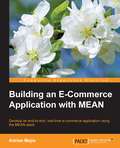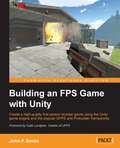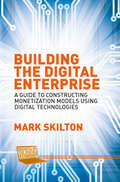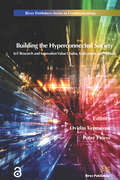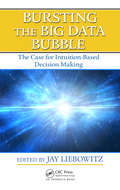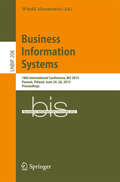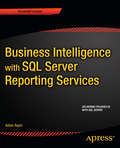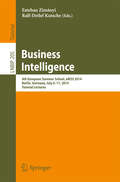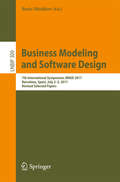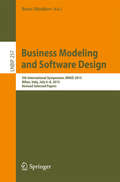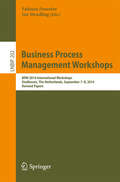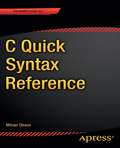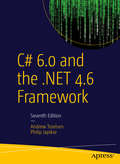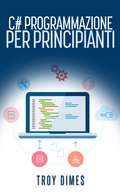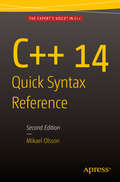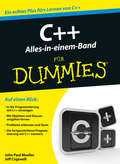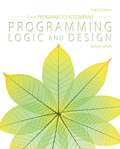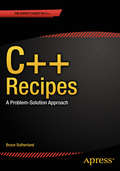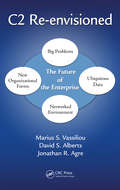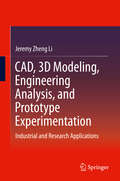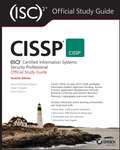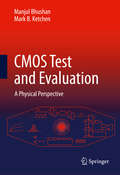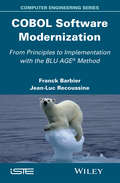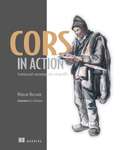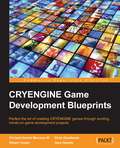- Table View
- List View
Building an E-Commerce Application with MEAN
by Adrian MejiaDevelop an end-to-end, real-time e-commerce application using the MEAN stack About This Book * Build all the main components of an e-commerce website and extend its high-quality features as per your needs * Get to grips with the full-stack JavaScript to build attractive e-commerce sites and start making money * A step-by-step guide to developing the MEAN stack components from scratch to achieve maximum flexibility when building an e-commerce application Who This Book Is For This book is for a web or full stack JavaScript developer who wants to get a head start on developing an e-commerce application with MEAN. A basic knowledge of the MEAN stack is highly recommended. What You Will Learn * Employ AngularJS to build responsive UI components * Implement multiple authentication strategies such as OAuth, JsonWebToken, and Sessions * Enhance website usability with social logins such as Facebook, Twitter, and Google * Create integrations with payment platforms such as PayPal * Apply full-text search functionality in MongoDB * Build a flexible categorization system to organize your products * Secure your app by creating SSL certificates and run payment platforms in a live environment In Detail MEAN stands for MongoDB, Express, AngularJS, and Node.js. It is a combination of a NoSQL database, MongoDB, with a couple of JavaScript web application frameworks, namely Express.js and Angular.js. These run on Node.js. There is always an ever-growing list of requirements while designing an e-commerce application, which needs to be flexible enough for easy adaptation. The MEAN stack allows you to meet those requirements on time and build responsive applications using JavaScript. This book will show you how to create your own e-commerce application using the MEAN stack. It will take you step by step through the parallel process of learning and building. It will also teach you to develop a production-ready, high-quality e-commerce site from scratch and will provide the knowledge you need to extend your own features to the e-commerce site. This book starts with a short introduction to the MEAN stack, followed by a step-by-step guide on how to build a store with AngularJS, set up a database with MongoDB, create a REST API, and wire AngularJS. It also shows you how to manage user authentication and authorization, check multiple payment platforms, add products' search and navigation, deploy a production-ready e-commerce site, and finally add your own high-quality feature to the site. By the end of the book, you will be able to build and use your own e-commerce app in the real world and will also be able to add your own new features to it. Style and approach This book is a step-by-step guide on how to build a real-time e-commerce app with MEAN. Each transition is well explained, and each chapter begins with the required background knowledge.
Building an FPS Game with Unity
by John P. DoranCreate a high-quality first person shooter game using the Unity game engine and the popular UFPS and Probuilder frameworksAbout This BookLearn how to use Unity in conjunction with UFPS and ProBuilder to create a high-quality game quicklyCreate both interior and exterior environmentsA step-by step guide to building a project with clear examples and instructions to create a number of interesting scenariosWho This Book Is ForThis book is for those who want to create an FPS game in Unity and gain knowledge on how to customize it to be their very own. If you are familiar with the basics of Unity, you will have an easier time, but it should make it possible for someone with no prior experience to learn Unity at an accelerated pace.What You Will LearnUse UFPS to build custom weapons with custom meshes and behaviorsExplore level design as you prototype levels, making use of Prototype to build levels out quicklyBuild environments that are realistic as possible while keeping peak performance and repetitiveness downReview tips and tricks on how to create environments using both terrain for outdoor areas and a modular workflow for interiorsDevelop a number of different encounters that your players can fight against, from a simple turret enemy to complex AI characters from Shooter AIDiscover how to create unique objects such as exploding barrels and objects you can interact withCreate a custom GUI to help your game stand out from the crowdPackage your game for release, create an installer, and get your game out into the worldIn DetailUnity, available in free and pro versions, is one of the most popular third-party game engines available. It is a cross-platform game engine, making it easy to write your game once and then port it to PC, consoles, and even the web, making it a great choice for both indie and AAA developers.Building an FPS Game in Unity takes readers on an exploration of how to use Unity to create a 3D first person shooter (FPS) title, leveraging the powerful UFPS framework by VisionPunk and Prototype/ProBuilder 2.0 by ProCore3D.After some setting up, you will start by learning how to create custom weapons, prototype levels, create exterior and interior environments, and breathe life into our levels. We will then add polish to the levels. Finally, we will create a custom GUI and menus for our title to create a complete package.Style and approachAn easy-to-follow guide with each project containing step-by-step explanations, diagrams, screenshots, and downloadable material. Concepts in Unity and C# are explained as they are used and for the more inquisitive, there are more details on the concepts used with additional external resources to learn from.
Building the Digital Enterprise: A Guide to Constructing Monetization Models Using Digital Technologies (Business in the Digital Economy)
by Mark SkiltonThe digital economy is at a tipping point. This practical book defines digital ecosystems, discusses digital design using converging technologies of social networking, mobility, big data and cloud computing, and provides a methods for linking digital technologies together to meet the challenges of building a digital enterprise in the new economy.
Building the Hyperconnected Society- Internet of Things Research and Innovation Value Chains, Ecosystems and Markets
by Ovidiu Vermesan Peter FriessThis book aims to provide a broad overview of various topics of Internet of Things (IoT), ranging from research, innovation and development priorities to enabling technologies, nanoelectronics, cyber-physical systems, architecture, interoperability and industrial applications. All this is happening in a global context, building towards intelligent, interconnected decision making as an essential driver for new growth and co-competition across a wider set of markets. It is intended to be a standalone book in a series that covers the Internet of Things activities of the IERC – Internet of Things European Research Cluster from research to technological innovation, validation and deployment.The book builds on the ideas put forward by the European Research Cluster on the Internet of Things Strategic Research and Innovation Agenda, and presents global views and state of the art results on the challenges facing the research, innovation, development and deployment of IoT in future years. The concept of IoT could disrupt consumer and industrial product markets generating new revenues and serving as a growth driver for semiconductor, networking equipment, and service provider end-markets globally. This will create new application and product end-markets, change the value chain of companies that creates the IoT technology and deploy it in various end sectors, while impacting the business models of semiconductor, software, device, communication and service provider stakeholders. The proliferation of intelligent devices at the edge of the network with the introduction of embedded software and app-driven hardware into manufactured devices, and the ability, through embedded software/hardware developments, to monetize those device functions and features by offering novel solutions, could generate completely new types of revenue streams. Intelligent and IoT devices leverage software, software licensing, entitlement management, and Internet connectivity in ways that address many of the societal challenges that we will face in the next decade.
Bursting the Big Data Bubble: The Case for Intuition-Based Decision Making
by Jay LiebowitzAs we get caught up in the quagmire of big data and analytics, it is important to be able to reflect and apply insights, experience, and intuition as part of the decision-making process. This book focuses on this intuition-based decision making. The first part of the book presents contributions from leading researchers worldwide on the topic of intuition-based decision making as applied to management. In the second part, executives and senior managers in industry, government, universities, and not-for-profits present vignettes that illustrate how they have used intuition in making key decisions.
Business Information Systems: 18th International Conference, BIS 2015, Poznań, Poland, June 24-26, 2015, Proceedings (Lecture Notes in Business Information Processing #208)
by Witold AbramowiczThis book contains the refereed proceedings of the 18th International Conference on Business Information Systems, BIS 2015, held in Pozna, Poland, in June 2015. The BIS conference series follows trends in academic and business research; thus, the theme of the BIS 2015 conference was "Making Big Data Smarter. " Big data is now a fairly mature concept, recognized and widely used by professionals in both research and industry. Together, they work on developing more adequate and efficient tools for data processing and analyzing, thus turning "big data" into "smart data. " The 26 revised full papers were carefully reviewed and selected from 70 submissions. In addition, two invited papers are included in this book. They are grouped into sections on big and smart data, semantic technologies, content retrieval and filtering, business process management and mining, collaboration, enterprise architecture and business−IT alignment, specific BIS applications, and open data for BIS.
Business Intelligence with SQL Server Reporting Services
by Adam AspinBusiness Intelligence with SQL Server Reporting Services helps you deliver business intelligence with panache. Harness the power of the Reporting Services toolkit to combine charts, gauges, sparklines, indicators, and maps into compelling dashboards and scorecards. Create compelling visualizations that seize your audience's attention and help business users identify and react swiftly to changing business conditions. Best of all, you'll do all these things by creating new value from software that is already installed and paid for - SQL Server and the included SQL Server Reporting Services. Businesses run on numbers, and good business intelligence systems make the critical numbers immediately and conveniently accessible. Business users want access to key performance indicators in the office, at the beach, and while riding the subway home after a day's work. Business Intelligence with SQL Server Reporting Services helps you meet these need for anywhere/anytime access by including chapters specifically showing how to deliver on modern devices such as smart phones and tablets. You'll learn to deliver the same information, with similar look-and-feel, across the entire range of devices used in business today. Key performance indicators give fast notification of business unit performancePolished dashboards deliver essential metrics and strategic comparisonsVisually arresting output on multiple devices focuses attention
Business Intelligence: 4th European Summer School, eBISS 2014, Berlin, Germany, July 6-11, 2014, Tutorial Lectures (Lecture Notes in Business Information Processing #205)
by Esteban Zimányi Ralf-Detlef KutscheThis book constitutes the tutorial lectures of the 4th European Business Intelligence Summer School, eBISS 2014, held in Berlin, Germany, in July 2014. The tutorials presented here in an extended and refined format were given by renowned experts and cover topics including requirements engineering for decision-support systems, visual analytics of large data sets, linked data and semantic technologies, supervised classification on data streams, and knowledge reuse in large organizations.
Business Modeling and Software Design: 4th International Symposium, Bmsd 2014, Luxembourg, Luxembourg, June 24-26, 2014, Revised Selected Papers (Lecture Notes In Business Information Processing #220)
by Boris ShishkovThis book contains revised and extended versions of selected papers from the 7th International Symposium on Business Modeling and Software Design, BMSD 2017, held in Barcelona, Spain, in July 2017. BMSD 2017 received a total of 57 paper submissions. The 10 papers selected for inclusion in this book deal with topics such as: business processes and enterprise engineering; business models and requirements; business models and services; business models and software; information systems architectures and paradigms; and data aspects in business modeling and software development.
Business Modeling and Software Design: 5th International Symposium, BMSD 2015, Milan, Italy, July 6–8, 2015, Revised Selected Papers (Lecture Notes in Business Information Processing #257)
by Boris ShishkovThis book contains the extended and revised versions of selected papers from the 4th International Symposium on Business Modeling and Software Design, BMSD 2014, held in Luxembourg, Luxembourg, in June 2014. The symposium was organized and sponsored by the Interdisciplinary Institute for Collaboration and Research on Enterprise Systems and Technology (IICREST), in collaboration with the Public Research Centre Henri Tudor (TUDOR). Cooperating organizations were the Dutch Research School for Information and Knowledge Systems (SIKS), Aristotle University of Thessaloniki (AUTH), the UTwente Center for Telematics and Information Technology (CTIT), and AMAKOTA Ltd. The 37 papers presented at BMSD 2014 were selected from 52 submissions. The seven papers published in this book were carefully reviewed, selected, revised, and extended from the presented papers. The selection considers a large number of BMSD-relevant research topics: from modeling and simulation-related subjects, such as declarative business rules, business (process) modeling, business process simulation, and information systems modeling, through architectures-related areas, such as impact analysis with regard to enterprise architectures and architectural principles for service cloud applications, to topics touching upon quality-of-service-aware service systems.
Business Process Management Workshops: BPM 2014 International Workshops, Eindhoven, The Netherlands, September 7-8, 2014, Revised Papers (Lecture Notes in Business Information Processing #202)
by Jan Mendling Fabiana FournierThis book constitutes the refereed proceedings of ten international workshops held in Eindhoven, The Netherlands, in conjunction with the 12th International Conference on Business Process Management, BPM 2014, in September 2014. The ten workshops comprised Process-oriented Information Systems in Healthcare (ProHealth 2014), Security in Business Processes (SBP 2014), Process Model Collections: Management and Reuse (PMC-MR 2014), Business Processes in Collective Adaptive Systems (BPCAS 2014), Data- and Artifact-centric BPM (DAB 2014), Business Process Intelligence (BPI 2014), Business Process Management in the Cloud (BPMC 2014), Theory and Applications of Process Visualization (TaProViz 2014), Business Process Management and Social Software (BPMS2 2014) and Decision Mining and Modeling for Business Processes (DeMiMoP 2014). The 38 revised full and eight short papers presented were carefully reviewed and selected from 84 submissions. In addition, six short papers resulting from the Doctoral Consortium at BPM 2014 are included in this book.
C Quick Syntax Reference: A Pocket Guide To The Language, Apis And Library
by Mikael OlssonThe C Quick Syntax Reference is a condensed code and syntax reference to the popular C programming language, which has enjoyed some resurgence of late. C's efficiency makes it a popular choice in a wide variety of applications and operating systems with special applicability to, for instance, wearables, game programming, system level programming, embedded device/firmware programming and in Arduino and related electronics hobbies. This book presents the essential C syntax in a well-organized format that can be used as a quick and handy reference. You won't find any technical jargon, bloated samples, drawn out history lessons, or witty stories in this book. What you will find is a language reference that is concise, to the point and highly accessible. The book is packed with useful information and is a must-have for any C programmer. In the C Quick Syntax Reference, you will find: A concise reference to the C language syntax. Short, simple, and focused code examples. A well laid out table of contents and a comprehensive index allowing easy review.
C# 6.0 and the .NET 4.6 Framework
by Philip Japikse Andrew TroelsenThis new 7th edition of Pro C# 6. 0 and the . NET 4. 6 Platform has been completely revised and rewritten to reflect the latest changes to the C# language specification and new advances in the . NET Framework. You'll find new chapters covering all the important new features that make . NET 4. 6 the most comprehensive release yet, including: A Refined ADO. NET Entity Framework Programming Model Numerous IDE and MVVM Enhancements for WPF Desktop Development Numerous updates to the ASP. NET Web APIs This comes on top of award winning coverage of core C# features, both old and new, that have made the previous editions of this book so popular. Readers will gain a solid foundation of object-oriented development techniques, attributes and reflection, generics and collections as well as numerous advanced topics not found in other texts (such as CIL opcodes and emitting dynamic assemblies). The mission of this book is to provide you with a comprehensive foundation in the C# programming language and the core aspects of the . NET platform plus overviews of technologies built on top of C# and . NET (ADO. NET and Entity Framework, Windows Communication Foundation (WCF), Windows Presentation Foundation (WPF), ASP. NET (WebForms, MVC, WebAPI). ). Once you digest the information presented in these chapters, you'll be in a perfect position to apply this knowledge to your specific programming assignments, and you'll be well equipped to explore the . NET universe on your own terms. What You Will Learn: Be the first to understand the . NET 4. 6 platform and C# 6. Discover the ins and outs of the leading . NET technology. Learn from an award-winning author who has been teaching the . NET world since version 1. 0. Find complete coverage of XAML, . NET 4. 6 and Visual Studio 2015 together with discussion of the new Windows Runtime.
C# Programmazione per principianti
by Alessandro Consorti Troy DimesUna delle cose migliori di C# è che è facile da imparare ... soprattutto con questo libro. Descrizione libro Data di pubblicazione: 23 gen 2015 C # è semplice, ma potente. C # è un linguaggio di programmazione orientato agli oggetti semplice e polivalente. Combinate questo con la sua versatilità e l'enorme libreria standard e sarà facile capire perché è un linguaggio di programmazione popolare e rispettato. Creare applicazioni grafiche, applicazioni web based, e altro ancora. Quando si impara a programmare in C# si sarà in grado di sviluppare applicazioni basate su web o applicazioni desktop grafiche. Una delle cose migliori di C# è che è facile da imparare ... soprattutto con questo libro. Ecco solo alcune delle cose che imparerete ... Cos'è un IDE e quale si dovrebbe utilizzare per lo sviluppo di applicazioni C#. Come creare il vostro primo programma. I vari tipi di dati utilizzati in C#. Gli operatori ... aritmetici, relazionali e logici. Come iterare in un insieme di elementi utilizzando 4 diversi tipi di cicli. Metodi per prendere decisioni nel codice. A proposito di programmazione orientata agli oggetti (OOP). Cosa sono gli oggetti e le classi. Tutto su modificatori e metodi. Argomenti avanzati come ereditarietà e polimorfismo. Come creare applicazioni multi-thread per sfruttare più CPU in una sola volta. Altro ... Esercizi di pratica inclusi che aiutano a realizzare codice C# che esegua "click" per voi. Include un esercizio alla fine di ogni capitolo (insieme alla soluzione) in modo da poter mettere in pratica ciò che avete imparato. Ottimo per programmatori che iniziano o quelli che sono nuovi al linguaggio Java. Se non avete mai programmato prima, non preoccupatevi. Questo libro vi guiderà passo per passo nella creazione della vostra prima applicazione software. Se avete qualche esperienza di programmazione
C++ 14 Quick Syntax Reference: Second Edition
by Mikael OlssonThis updated handy quick C++ 14 guide is a condensed code and syntax reference based on the newly updated C++ 14 release of the popular programming language. It presents the essential C++ syntax in a well-organized format that can be used as a handy reference. You won't find any technical jargon, bloated samples, drawn out history lessons, or witty stories in this book. What you will find is a language reference that is concise, to the point and highly accessible. The book is packed with useful information and is a must-have for any C++ programmer. In the C++ 14 Quick Syntax Reference, Second Edition, you will find a concise reference to the C++ 14 language syntax. It has short, simple, and focused code examples. This book includes a well laid out table of contents and a comprehensive index allowing for easy review. What you'll learn How to create a C++ HelloWorld How to compile and run What are C++ variables, operators, pointers and references What are arrays, strings, conditionals, loops and more How to write functions How to work with constructors, inheritance, overridings How to use access levels, static, enum, string and union, and more What are custom conversions, namespaces, constants, and preprocessors How to do event handling What are type conversions, templates, headers, and more Who this book is for This book is a quick, handy pocket syntax reference for experienced C++ programmers, and a concise, easily-digested introduction for other programmers new to C++. Table of Contents 1. HelloWorld 2. Compile and Run 3. Variables 4. Operators 5. Pointers 6. References 7. Arrays 8. String 9. Conditionals 10. Loops 11. Functions 12. Class 13. Constructor 14. Inheritance 15. Overriding 16. Access Levels 17. Static 18. Enum 19. String and Union 20. Operator Overloading 21. Custom Conversions 22. Namespaces 23. Constants 24. Preprocessor 25. Event Handling 26. Type Conversions 27. Templates 28. Headers
C++ Alles in einem Band für Dummies (Für Dummies)
by John Paul Mueller Jeffrey M. CogswellDieses Buch ist für alle, die tief in die C++-Programmierung einsteigen möchten. Dennoch werden keine Programmierkenntnisse vorausgesetzt. John Paul Mueller und Jeff Cogswell erklären Ihnen zunächst, wie Sie C++ installieren. Sie erfahren, was Klassen und Objekte sind, was Sie mit Entwurfsmustern anfangen und wie Sie Ihre Programme debuggen. Aus Anfängern werden Entwickler mit Erfahrung und dann fortgeschrittene Programmierer. Diese finden in diesem Buch Informationen zu dynamischen Arrays, Lambda-Ausdrücken, Streams, UML, der Standardbibliothek, zu Boost und vielem mehr. Alle Codebeispiele des Buchs stehen zum Download zur Verfügung.
C++ Programs to Accompany Programming Logic and Design, Eighth Edition
by Jo Ann SmithAlso known as C++ PAL), the book is designed to provide students with an opportunity to write C++ programs as part of an Introductory Programming Logic course. This textbook assumes no programming language experience and provides the beginning programmer with a guide to writing structured programs and simple object-oriented programs using introductory elements of the popular C++ programming language.
C++ Recipes: A Problem-Solution Approach
by Bruce SutherlandIn this handy reference, you'll find numbers, strings, dates, times, classes, exceptions, streams, flows, pointers and more. Also, you'll see various code samples, templates for C++ algorithms, parallel processing, multithreading and numerical processes. These have many applications including game development, big data analytics, financial engineering and analysis, enterprise applications and more. A wealth of STL templates on function objects, adapters, allocators, and extensions are also available. C++ Recipes: A Problem-Solution Approach is a handy code cookbook reference guide that cover the latest C++ 14 as well as some of the code templates available in the latest Standard Template Library (STL). This is a "must have", contemporary reference for your technical library. What you'll learn How to handle numbers, strings, text, dates and times, and data in general How to implement a variety of C++ algorithms How to handle and use classes, exceptions, streams and flows How to build parallel processing C++ templates How to code for pointers How to leverage the wealth of C++ templates found in the STL, including function objects, adapters, allocators and more How to extend the STL and more Who this book is for This book is for those with at least some experience with C++ and certainly experience with programming in general. Table of Contents 1. Beginning C++ 2. Modern C++ 3. Working with Text 4. Working with Numbers 5. Classes 6. Inheritance 7. The STL Containers 8. The STL Algorithms 9. Templates 10. Memory 11. Concurrency 12. Networking 13. Scripting 14. 3D Graphics Programming
C2 Re-envisioned: The Future of the Enterprise
by Marius S. Vassiliou David S. Alberts Jonathan Russell AgreCommand and Control (C2) is the set of organizational and technical attributes and processes by which an enterprise marshals and employs human, physical, and information resources to solve problems and accomplish missions.C2 Re-envisioned: The Future of the Enterprise identifies four interrelated megatrends that are individually and collectively sh
CAD, 3D Modeling, Engineering Analysis, and Prototype Experimentation: Industrial and Research Applications
by Jeremy Zheng LiThis succinct book focuses on computer aided design (CAD), 3-D modeling, and engineering analysis and the ways they can be applied effectively in research and industrial sectors including aerospace, defense, automotive, and consumer products. These efficient tools, deployed for R&D in the laboratory and the field, perform efficiently three-dimensional modeling of finished products, render complex geometrical product designs, facilitate structural analysis and optimal product design, produce graphic and engineering drawings, and generate production documentation. Written with an eye toward green energy installations and novel manufacturing facilities, this concise volume enables scientific researchers and engineering professionals to learn design techniques, control existing and complex issues, proficiently use CAD tools, visualize technical fundamentals, and gain analytic and technical skills. This book also: · Equips practitioners and researchers to handle powerful tools for engineering design and analysis using many detailed illustrations · Emphasizes important engineering design principles in introducing readers to a range of techniques · Includes tutorials providing readers with appropriate scaffolding to accelerate their learning process · Adopts a product development, cost-consideration perspective through the book's many examples
CISSP: Certified Information Systems Security Professional Study Guide (Sybex Serious Skills Ser.)
by Darril Gibson Mike Chapple James M. StewartCISSP Study Guide - fully updated for the 2015 CISSP Body of Knowledge CISSP (ISC)2 Certified Information Systems Security Professional Official Study Guide, 7th Edition has been completely updated for the latest 2015 CISSP Body of Knowledge. This bestselling Sybex study guide covers 100% of all exam objectives. You'll prepare for the exam smarter and faster with Sybex thanks to expert content, real-world examples, advice on passing each section of the exam, access to the Sybex online interactive learning environment, and much more. Reinforce what you've learned with key topic exam essentials and chapter review questions. Along with the book, you also get access to Sybex's superior online interactive learning environment that includes: Four unique 250 question practice exams to help you identify where you need to study more. Get more than 90 percent of the answers correct, and you're ready to take the certification exam. More than 1,000 Electronic Flashcards to reinforce your learning and give you last-minute test prep before the exam A searchable glossary in PDF to give you instant access to the key terms you need to know for the exam Coverage of all of the exam topics in the book means you'll be ready for: Security and Risk Management Asset Security Security Engineering Communication and Network Security Identity and Access Management Security Assessment and Testing Security Operations Software Development Security
CMOS Test and Evaluation: A Physical Perspective
by Mark B. Ketchen Manjul BhushanCMOS Test and Evaluation: A Physical Perspective is a single source for an integrated view of test and data analysis methodology for CMOS products, covering circuit sensitivities to MOSFET characteristics, impact of silicon technology process variability, applications of embedded test structures and sensors, product yield, and reliability over the lifetime of the product. This book also covers statistical data analysis and visualization techniques, test equipment and CMOS product specifications, and examines product behavior over its full voltage, temperature and frequency range.
COBOL Software Modernization
by Jean-Luc Recoussine Franck BarbierNowadays, billions of lines of code are in the COBOL programming language. This book is an analysis, a diagnosis, a strategy, a MDD method and a tool to transform legacy COBOL into modernized applications that comply with Internet computing, Service-Oriented Architecture (SOA) and the Cloud. It serves as a blueprint for those in charge of finding solutions to this considerable challenge.
CORS in Action: Creating and consuming cross-origin APIs
by Monsur HossainSummaryCORS in Action introduces Cross-Origin Resource Sharing (CORS) from both the server and the client perspective. It starts with the basics: how to make CORS requests and how to implement CORS on the server. It then explores key details such as performance, debugging, and security. API authors will learn how CORS opens their APIs to a wider range of users. JavaScript developers will find valuable techniques for building rich web apps that can take advantage of APIs hosted anywhere. The techniques described in this book are especially applicable to mobile environments, where browsers are guaranteed to support CORS. Purchase of the print book includes a free eBook in PDF, Kindle, and ePub formats from Manning Publications. About the BookSuppose you need to share some JSON data with another application or service. If everything is hosted on one domain, it's a snap. But if the data is on another domain, the browser's "same-origin" policy stops you cold. CORS is a new web standard that enables safe cross-domain access without complex server-side code. Mastering CORS makes it possible for web and mobile applications to share data simply and securely. CORS in Action introduces CORS from both the server and the client perspective. It starts with making and enabling CORS requests and then explores performance, debugging, and security. You'll learn to build apps that can take advantage of APIs hosted anywhere and how to write APIs that expand your products to a wider range of users. For web developers comfortable with JavaScript. No experience with CORS is assumed.What's InsideCORS from the ground upServing and consuming cross-domain dataBest practices for building CORS APIsWhen to use CORS alternatives like JSON-P and proxiesAbout the AuthorMonsur Hossain is an engineer at Google who has worked on API-related projects such as the Google JavaScript Client, the APIs Discovery Service, and CORS support for Google APIs.Table of ContentsPART 1 INTRODUCING CORSThe Core of CORSMaking CORS requestsPART 2 CORS ON THE SERVERHandling CORS requestsHandling preflight requestsCookies and response headersBest practicesPART 3 DEBUGGING CORS REQUESTSDebugging CORS requests APPENDIXESCORS referenceConfiguring your environmentWhat is CSRF?Other cross-origin techniques
CRYENGINE Game Development Blueprints
by Richard Gerard Marcoux III Chris GoodswenPerfect the art of creating CRYENGINE games through exciting, hands-on game development projects About This Book * Create CRYENGINE games from scratch with CRYENGINE Blank Game Starter-kit * Discover good working practices and tips to quickly jump into making a new level in the game * Build practical game projects and discover advanced concepts of CRYENGINE game development using the examples in the book Who This Book Is For This book is intended for CRYENGINE game developers, wanting to develop their skills with the help of industry experts. A good knowledge level and understanding of CRYENGINE is assumed, to allow efficient programming of core elements and applications. What You Will Learn * Create a CRYENGINE game from scratch with the Game Starter-kit * Add custom methods to allow the player/AI to use a weapon * Create complete "start" and "end" game menus using Scaleform and C++ * Discover how to use highpoly modeling workflow and techniques within the pipeline for the SDK to use * Use the Crytiff exporter from Photoshop * Export the CHR--the format the engine needs to read the skeleton * Integrate the character in the engine using the character tool * Better understand the rules to create and author skeletons to rig characters designed for CRYENGINE * Debug common setup issues that might appear during production with useful tools In Detail CRYENGINE is a game engine developed by Crytek for PC, Playstation, Xbox, Android, and iOS. It can be used to create AAA games, movies, high-quality simulations, and interactive applications. It is most popularly used for game development. In this book, you will start off by exploring the CRYENGINE "Blank" Game Starter-kit, creating a completely playable character from scratch and controlling its movement. You will learn how to implement a weapon and ammo class, and will create complete "start" and "end" game menus using Scaleform and C++. Additionally, you will learn some key texturing techniques for PBR and how to create and bake maps to the lowpoly model. You will also explore how to get a static model from Maya and shaders setbup in the SDK to check the textures during creation, and create all the necessary engine files to export and see the game character's animations in your engine. In the final third of the book, you will learn how to create objectives, set up saved games, layer on audio polish to help immerse the player in the experience, and debug game issues. Style and approach An easy-to-follow, practical guide covering three exciting projects. As you work through each project you will explore new topics including complex animation, advanced scripting, and complex character motion. All the code used in each project is explained in detail.
